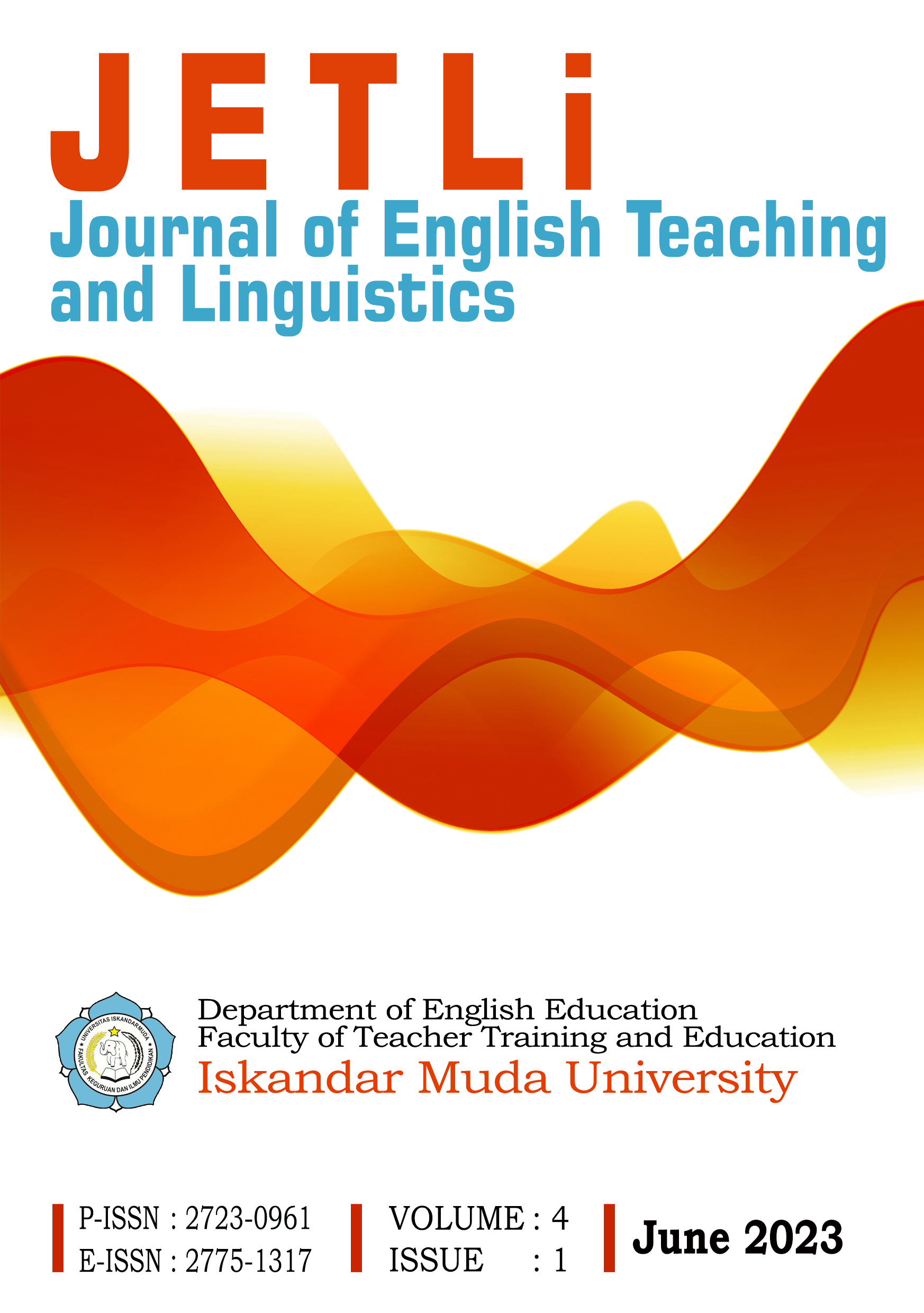An Analysis of Grammatical Errors from Indonesian into English in Translating Descriptive Texts
DOI:
https://doi.org/10.55616/jetli.v4i1.519Keywords:
Descriptive Text, Grammatical Errors, TranslationAbstract
Translating is such a difficult activity and needs some efforts to master this skill, particularly when it is done by students. This research examines the analysis of grammatical errors in translating texts from Indonesian to English with the aim of being able to answer the following questions: What types of grammar are often misinterpreted by students in interpreting a language? In this field, the method used is descriptive qualitative method and text translation. The data was token from 15 students in one class. The results of the analysis found several errors such as 35 (63.63%) word replacement errors, 15 (27.28%) word omissions, 4 (7.28%) word additions and word rearrangement 1 (100%). In which all errors are found are 261. The most common mistake that occurs is substitution. The use of Past Tenses is one of the causes of students' difficulties in translating descriptive texts. From the results it can be suggested that should be able to teach students how students how to translate texts correctly and provide time or opportunity for students to practice focusing on grammar, especially in using tenses, verbs, articles, auxiliary verbs, noun phrases and pronouns.
References
Abbasi, M., & Karimnia, A. (2011). An Analysis of Grammatical Errors among Iranian Translation Students: Insights from Interlanguage Theory. European Journal of Social Sciences, 25(4), 1–12.
Afifah, A. (2022). ERROR ANALYSIS ON SENTENCE CONSTRUCTION BY USING GRAMMAR TRANSLATION METHOD TO THE FIRST SEMESTER STUDENTS OF ARABIC EDUCATION STUDY PROGRAM AT DATOKARAMA STATE ISLAMIC UNIVERSITY PALU. Jurnal Pendidikan dan Pembelajaran, 5(2). 1–5.
Aini, N. (2018). The Grammatical Errors in the Translational Text: Indonesian-English Structure. TELL Journal, 6(2), 55-61. http://dx.doi.org/10.30651/tell.v6i2.2109
Ayouni, N., & El-Sukny, M. (2022). An Analysis on Elicitation as Corrective Feedback to Students’ Grammar Errors. Journal of English Teaching and Linguistics, 3(2), 109-115. https://doi.org/10.55616/jetli.v3i2.393
Bukit, H. (2020). THE ERROR ANALYSIS IN USING TENSES MADE BY STUDENTS IN ENGLISH TEACHING AND LEARNING PROCESS. Journal of English Teaching and Linguistics, 1(2), 92-101. https://doi.org/10.55616/jetli.v1i2.21
I.P.B. Erlangga., I.W. Suarnajaya., & P.A.K. Juniarta. (2019). AN ANALYSIS OF GRAMMATICAL ERRORS MADE BY THE SEVENTH GRADE STUDENTS OF SMP NEGERI 2 SUKAWATI IN WRITING DESCRIPTIVE TEXTS IN THE ACADEMIC YEAR 2018/2019. LEJU, 2(1). 1–11.
Istiqomah, Y., & Hasbullah, H. (2021). Pengaruh Penguasaan Kosakata Dan Tata Bahasa Terhadap Kemampuan Menulis Teks Recount Bahasa Inggris. INFERENCE: Journal of English Language Teaching, 4(3). 296-303. http://dx.doi.org/10.30998/inference.v4i3.6948
Koman, H., Hartono, R., & Yuliasri, I. (2019). Translation Errors in Students’ Indonesian-English Translation Practice. English Education Journal, 9(2), 206-218. https://doi.org/10.15294/eej.v9i2.29372
Kombong, M. T. (2015). GRAMMATICAL ERROR MADE BY THE STUDENTS OF UKI TORAJA IN TRANSLATING INDONESIA-ENGLISH TEXT. Teaching English as a Foreign Language Overseas Journal (TEFLO), 1(1). 126-136.
Khoirunida, S. (2019). AN ANALYSIS OF GRAMMATICAL ERRORS IN THE TRANSLATION MADE BY THE FOURTH SEMESTER STUDENTS OF ENGLISH EDUCATION PROGRAM. JELLT (Journal of English Language and Language Teaching), 3(2), 114–125. https://doi.org/10.36597/jellt.v3i2.5999
Londoño Vásquez, D. A. (2008). Error Analysis in a Written Composition. Profile: Issues in Teachers’ Professional Development, 10(1), 135–146. https://revistas.unal.edu.co/index.php/profile/article/view/10619
Prasetyaningrum, A., & Asrobi, M. (2020). Elaboration on Grammatical Errors of Descriptive Text by EFL Learners. Atlantis Press SARL, 1–5.
Putri, T. A. (2019). AN ANALYSIS OF TYPES AND CAUSES OF TRANSLATION ERRORS. ETNOLINGUAL, 3(2), 93–103. https://doi.org/10.20473/etno.v3i2.15028
Rafsanjani, A. A. (2019). Errors Analysis in Bahasa Indonesia to English Translation in Descriptive Text Made by Indonesian Students. Atlantis Press SARL, 443. 1–4.
Rahmannia, M., & Triyono, S. (2019). A Study of Google Translate Translations: An Error Analysis of Indonesian-to-English Texts. International Journal of Linguistics, Literature and Translation (IJLLT) 2(3),196-200. https://ssrn.com/abstract=3456744
Rohim, A., & Putra, A. S. (2022). IDENTIFICATION OF STUDENT’S LEXICAL ERROR IN TRANSLATING ENGLISH TEXT INTO INDONESIAN. An English-Indonesian Journal for English, Education, and Culture, 11(1). 15-19. http://dx.doi.org/10.31000/globish.v11i1.5511
Saputra, U. H. A., Arifin, A., & Harida, R. (2022). ERROR IN DESCRIPTIVE TEXT OF THE FOURTH SEMESTER STUDENTS OF ENGLISH DEPARTMENT. Jurnal Bahasa dan Sastra, 9(1), 53-59.
Sari, D. M. M. (2019). An Error Analysis on Student’s Translation Text. Jurnal Pendidikan Bahasa Asing dan Sastra, 3(2), 1–10.
Silalahi, M., Rafli, Z., & Rasyid, Y. (2018). The Analysis of Errors in Translation of Scientific Text from English to Indonesian Language. JETL (Journal of Education, Teaching and Learning), 3(1), 23-27. http://dx.doi.org/10.26737/jetl.v1i1.456
Tridinanti, G., & Budiyanto, D. ( 2017). ERRORS IN TRANSLATION BETWEEN SL INTO TL MADE BY THE STUDENTS OF TRIDINANTI UNIVERSITY OF PALEMBANG. Jurnal Didascein Bahasa, 3(1). 1–9. https://univ-tridinanti.ac.id/ejournal/index.php/bahasa/article/view/474
Utami, S. (2017). THE SOURCE OF ERRORS IN INDONESIAN-ENGLISH TRANSLATION. Jurnal Kata : Penelitian Tentang Ilmu Bahasa Dan Sastra, 1(2), 192-202. http://dx.doi.org/10.22216/jk.v1i2.2351
Wiratno, T., & Santosa, R. (2014). Bahasa, Fungsi Bahasa, dan Konteks Sosial: Pengantar Linguistik Umum. Jakarta: Universitas Terbuka.
Wongranu, P. (2017). Errors in translation made by English major students: A study on types and causes. Kasetsart Journal of Social Sciences, 38(2), 117-122. https://doi.org/10.1016/j.kjss.2016.11.003
Published
How to Cite
Issue
Section

This work is licensed under a Creative Commons Attribution 4.0 International License.
Authors retain copyright and grant the journal right of first publication with the work simultaneously licensed under an Attribution 4.0 International (CC BY 4.0) that allows others to share — copy and redistribute the material in any medium or format and adapt — remix, transform, and build upon the material for any purpose, even commercially with an acknowledgment of the work's authorship and initial publication in this journal.







 Journal of English Teaching and Linguistics
Journal of English Teaching and Linguistics